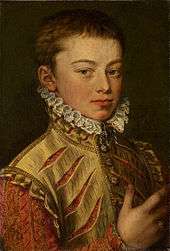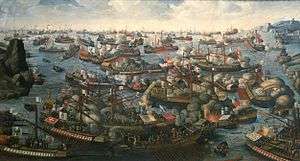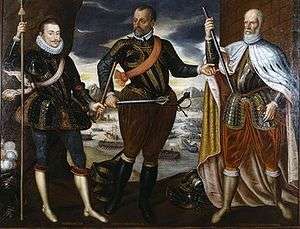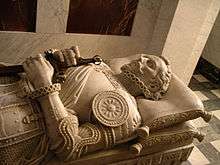John of Austria
John of Austria (24 February[1] 1547 – 1 October 1578), in English traditionally known as Don John of Austria, in Spanish as Don Juan de Austria[2] and in German as Ritter Johann von Österreich, was an illegitimate son of Holy Roman Emperor Charles V. He became a military leader in the service of his half-brother, King Philip II of Spain and is best known for his naval victory at the Battle of Lepanto in 1571 against the Ottoman Empire.
Childhood and youth
Born in the Free imperial city of Regensburg, Upper Palatinate, and raised in Spain, he was the progeny of a liaison between Emperor Charles V and Barbara Blomberg, a burgher's daughter and singer. Barbara was promptly married to Hieronymus Kegel, a court functionary in Brussels, and her child became known as Jeromín. Before he turned three, Jeromín was taken from his mother and put in the care of an old friend of Charles, Adrien de Bois who, in counsel with his wife, placed the child as theirs, under a Belgian court musician, Franz Massy and his Spanish wife, Ana de Medina. Given money for their travel and his keep, they took him to Spain and settled in 1550 at Leganés, her village just outside Madrid, where Jeromín learned Spanish and played with village boys, starting basic school with the priest at nearby Getafe. When Jeromín turned seven, by order of his father, the Emperor, a courtier took him from his now-widowed foster mother to the castle of Charles' majordomo, Don Luis de Quijada, in Villagarcía de Campos not far from Valladolid. Quijada's wife, Doña Madalena de Ulloa, took charge of Jeromín, grooming him in her household where he was given a solid curriculum of studies including Latin and French in addition to Spanish, his first language.

When Charles abdicated his Spanish crowns in 1556, he retired from Brussels to the remote monastery of Yuste in Spain. There he summoned Don Luis de Quijada to return as majordomo. In the summer of 1558, Quijada brought Madalena and Jeromín to Yuste, where Charles, on several occasions before his death that September, saw his son, now a youth of eleven. In a codicil to his will, Charles had made provision for Jeromín, and expressed hope that he would enter the clergy and pursue an ecclesiastical career.[3]:22
Charles' son and heir, Philip II of Spain, returned from Brussels in 1559, aware of his father's will. Settled in Valladolid, he summoned Quijada to bring Jeromín to a hunt. When Philip appeared, Quijada told Jeromín to dismount and make proper obeisance to his king. When Jeromín did so, Philip asked him if he knew the identity of his father. When the boy did not know, Philip embraced him and explained that they had the same father and thus were brothers. Philip, however, was strict regarding protocol: Jeromín was not to be addressed as "highness", the form reserved for royals and sovereign princes. In formal style he was "your excellency", the address used for a Spanish grandee, and known as Don Juan de Austria. Don John did not live in a royal palace, but maintained a separate household with Luis Quijada now heading his service. Philip allowed Don John the incomes allocated to him by Charles so that he might maintain the status proper to the son of an emperor and brother of a king. In public ceremonies, Don John stood, walked or rode behind the royal family, but ahead of the grandees.[3][4]
Philip's new queen, Elisabeth of Valois, was only a year older than Juan, and his ill-fated son by his first marriage, Don Carlos, only two years older. Often in the company of the lively young set was Don John's half-sister Joan, Princess of Portugal, a dozen years his senior. At the baptisms of his nieces, Elisabeth's daughters, Isabella Clara Eugenia and Catherine Michelle, it was Don John who carried the infants to the baptismal font. During and after the battle of Lepanto Don John was addressed in letters and in person as "Highness" and "Prince".[3][4]
Philip, following the directions of Charles V, sent Don John to the Complutense University in the company of Don Carlos and Alessandro Farnese, Prince of Parma and son of Charles V's other acknowledged illegitimate child, Margaret of Austria, Duchess of Parma (1522–86). This was meant to be a preparation for Don John's ecclesiastical career. At Alcalá in 1562, Carlos suffered a fractured skull that had a deleterious effect on his personality. In 1565, Farnese left to be married in Brussels, where his mother was Regent of Belgica Regia. From Farnese, Don John is said to have learned womanizing and, in time, acknowledged two illegitimate daughters, one in Spain, the other in Naples.[3][4]
Relationships and descendants
The following women are confirmed to have had a relationship with John of Austria:[4]
- Maria of Mendoza (1545 – 22 April 1570), lady-in-waiting of Joanna of Austria, Princess of Portugal and daughter of Diego Hurtado of Mendoza, Prince of Melito and 1st Duke of Francavilla.[5] They had one daughter:[3][4]
- Maria Ana of Austria (November 1569, Villagarcía de Campos, Madrid – 27 November 1629, Las Huelgas, Burgos), who later became Abbess of Santa María la Real de Las Huelgas since 1611.
- Anne of Toledo, with whom he had no known children.[3][4]
- Zenobia Sarotosia (born ca. 1540), daughter of Vincenzo Sarastrosio and Violante Garofano.[6] They had one son:
- Diana Falangola (born 1556), daughter of Scipione Falagona, Lord of Fagnano.[7] They had a daughter:
- Juana of Austria (11 September 1573, Naples – 7 February 1630, Militello),[3][4] who married at Palermo on 20 April 1603 with Francesco Branciforte, 2nd Prince of Pietrapersia. They had five daughters:[8]
- Margherita Branciforte d'Austria (11 January 1605, Naples – 24 January 1659, Rome), Princess of Butera; married with Federico Colonna, 5th Duke of Tagliacozzo, with whom she had one son:
- Antonio Colonna, Prince of Pietrapersia (1619 – 1623).[9]
- Flavia Branciforte d'Austria (3 June 1606, Naples – 24 May 1608, Naples).
- Caterina Branciforte d'Austria (4 May 1609, Naples – 6 June 1613, Naples).
- Elisabetta Branciforte d'Austria (9 December 1611, Naples – 7 August 1615, Naples).
- Anna Branciforte d'Austria (6 July 1615, Naples – 1 September 1615, Naples).
- Margherita Branciforte d'Austria (11 January 1605, Naples – 24 January 1659, Rome), Princess of Butera; married with Federico Colonna, 5th Duke of Tagliacozzo, with whom she had one son:
- Juana of Austria (11 September 1573, Naples – 7 February 1630, Militello),[3][4] who married at Palermo on 20 April 1603 with Francesco Branciforte, 2nd Prince of Pietrapersia. They had five daughters:[8]
Morisco Revolt in Granada
When news reached him at Christmastide of the revolt in Granada of the Moriscos (Moors who had converted to Christianity), he volunteered to serve in any capacity. The local grandees in charge, the Marquis of Mondéjar in Granada and the Marquis of los Vélez in Almeria, soon fell out over matters of tactics, strategy and the place of clemency. The revolt spread and aid came from Barbary and the Turks. In April 1569 Philip appointed Don John commander-in-chief with Quijada as his chief adviser.
In Granada, Don John built his forces with care, learning about logistics and drill. Requeséns and Santa Cruz patrolled the coast with their galleys, limiting aid and reinforcements from Barbary. In December Don John unexpectedly took the field with a large and well-supplied army. First clearing rebels from near Granada, he then marched east through Guadix, where veteran troops from Italy joined him, bringing his numbers to 12,000. In late January he assaulted the rebel stronghold of Galera. Fighting was long and hard and casualties heavy. When Galera fell, Don John had it levelled and salt ploughed into its soil. Between 400 and 4500 inhabitants were killed, and 2000 to 4500 survivors were sold into slavery.[10][11]
The War of Cyprus and Battle of Lepanto
.svg.png)
The War of Cyprus became the focus of Spain’s attention after Pope Pius V sent an envoy to urge Philip to join with him and Venice in a Holy League against the Turks. Philip agreed and negotiations opened in Rome. Among Philip's terms was the appointment of Don John as commander-in-chief of the Holy League armada. While he agreed that Cyprus should be relieved, he was also concerned to recover control of Tunis, where Turks had overthrown the regime of Philip's client Muslim ruler. Tunis posed an immediate threat to Sicily, one of Philip's kingdoms. Philip also had in mind the eventual conquest of Algiers, whose corsairs posed a constant nuisance to Spain. Charles V had tried, and failed, to take it in the course of the Algiers expedition (1541).
While Don John finished the pacification of Granada, negotiations dragged on in Rome. In the summer of 1570 Philip sailed for Cyprus under the pope's admiral Marcantonio Colonna. In charge of Philip's contingent was the Genoese Gian Andrea Doria, a great-nephew of the renowned Andrea Doria. On reaching the Turkish coast in September, Colonna and the Venetians wished to press on to Cyprus while Doria argued that the season had grown too late. Then news arrived that Nicosia, the capital of Cyprus, had fallen, and only the port of Famagusta held out. Sickness hit the Venetian fleet and a consensus grew that it was best to return to port. The weather turned ugly and while Doria reached port in good order, the Venetians were storm-battered. Among the Christian allies, animosities became open while the Turks tightened their siege of Famagusta.[12]:122
The Venetians repaired their galley fleet and readied six heavily armed galleasses. The Pope hired twelve galleys from the Grand Duke of Tuscany. The dukes of Savoy and Parma also provided galleys, and Alexander Farnese sailed in one. When the League was formally signed in May, Don John was designated commander-in-chief and given his many instructions by Philip. With the instructions came a warning not to involve himself with women, which, among other instructions, were ignored by Don John. It was late July before he sailed with the Spanish squadron from Barcelona, and mid-September before the entire Holy League armada got underway from Messina. Don John was determined to fight, rallying allies and quelling their mutual suspicions.[12]:133


Don John found the Turkish fleet at Lepanto in the Gulf of Corinth. After some debate, the Turks chose to fight, even though they had been at sea all summer and disbanded some of their people. They had the larger fleet, nearly 300 to Don John's 207 galleys and six galleasses. On 7 October 1571, the Turkish fleet emerged into the Gulf of Patras and took battle formation. Bringing his fleet through islets known as the Curzolaris (now mostly lost to the silting of the shoreline), Don John deployed his armada into a left wing under Venetian command, a right wing under Doria, a powerful center or main battle under himself, and a strong rear guard under the Marquis of Santa Cruz. In all four formations were galleys from each of the participating states. Two galleasses each were assigned to the wings and center. Around noon the battle commenced. The cannonade of the galleasses disrupted the Turkish formations as they pressed to the attack, and the bigger and more numerous guns of the Christian allies did devastating damage as the Turkish right and center closed to board. In the seesaw fighting on decks, the allies prevailed. Among their wounded was the 24-year-old Miguel de Cervantes, future writer of Don Quixote. Cervantes later wrote a description of the courage of the Christian combatants.[12]:150
The Turkish remaining under Uluj Ali, the governor general of Algiers and their best admiral, tried to outmaneuver Doria's wing, drawing it away from the League center. When a gap appeared between Doria and the center, Uluj Ali made a quick turn about and aimed at the gap, smashing three galleys of the Knights of Malta on Don John's right flank. Don John came around smartly while the Marquis of Santa Cruz hit Uluj Ali hard with his rear guard. Uluj Ali himself and maybe half his wing escaped. The victory was near total, with the Turkish fleet destroyed and thousands of veterans lost. The League's losses were hardly negligible, with over 13,000 dead, However, in the aftermath the Holy league forces managed to liberate over ten thousand Christian slaves, a mild compensation for their losses.[13] In the evening a storm broke and the victors had to head for port, while sporadic Greek uprisings were ruthlessly suppressed by the Turks. During and after the battle of Lepanto, Don John was addressed in letters and in person with "Highness" and "Prince". This was in contradiction to the initial protocol and address by Philip. There are no records to indicate if Philip gave Don John these honours.[3][4]
The Mediterranean after Lepanto
All looked forward to the campaign of 1572, but events in France, with the growth of Protestant Huguenot power, seemed to threaten Philip's Low Countries, where the Duke of Alba had restored an uneasy order. Philip ordered Don John to hold his part of the Holy League armada at Palermo, prepared to respond to events in France. Colonna took the rest into Greek waters, but achieved nothing. By the time Don John joined his allies in late summer, and attempted to take the Turkish citadel of Modon on the Peloponnesus (then known as the Morea), the Turks had too many reinforcements in place.
Don John wintered in Naples, from which he made his first visit to his half-sister Margaret, Duchess of Parma, in l'Aquila. They had corresponded for some time and would continue to do so. He confided in her about his love affairs, and after the birth of an illegitimate daughter had her delivered to Margaret's care. His relations with the new Viceroy of Naples, Cardinal Granvelle, an old and experienced diplomat, were not easy, but he did learn more of statecraft and the problems of northern Europe. At some point he began to entertain fantasies of liberating the Catholic Mary, Queen of Scots, held in prison in England for treason, and perhaps marrying her and taking England's throne. Such an idea received encouragement in Rome. In May 1572 Pope Pius V died; by early 1573, the Venetians, distrusting Philip II, made a separate peace with the Turks. Don John put his energy into the recovery of Tunis, which he achieved that fall, restoring a client Muslim ruler. Against advice from Madrid to raze Tunis and destroy its harbor and the great fortress of La Goletta, erected by Charles V after his conquest of Tunis in 1535, Don John chose to keep La Goletta, which had held out in 1570, and build a new fortress inside Tunis to dominate the city. He and the Marquis of Santa Cruz planned next to take Algiers, while critics, including Granvelle, hinted that Don John dreamed of becoming King of Tunis.
Governor Generalship of the Low Countries

Don John and Santa Cruz had planned a larger campaign for 1576, when in May he received the long-dreaded orders to proceed directly to the Low Countries as Governor General, following the death of Requeséns. In Rome he once more received encouragement in his schemes to liberate the Queen of Scots, making the governor-generalship more attractive. In northern Italy he halted, and sent his secretary Juan de Escobedo to Spain, to secure more money and win Philip's consent for his plans for the Queen of Scots. When by late summer Escobedo had not returned, Don John sailed for Spain. His shocked brother met with him privately at the Escorial. Philip seems to have accepted Don John’s plans for the Queen of Scots, but only after he had secured peace in the Low Countries. Because he was short of money, Philip expected Don John to achieve peace through diplomacy and negotiation. Having received his instructions, Don John and a few companions made a dash for the Low Countries across France, rent by religious civil war. Fearing Protestant assassins, Don John reportedly wore the disguise of a Moorish slave.
While grievances in the Low Countries were many, at the heart of the revolt was religion, Calvinism on the rebel side, Roman Catholicism on Philip's. Don John was a convinced Catholic, had crusaded for the Cross against the Muslim Turks and regarded Protestants simply as heretics. But some, particularly in the Low Countries, argued that limited toleration, and the suppression of the Inquisition might be the only feasible solution for the revolt. Of the historic seventeen provinces, Holland and Zeeland were largely in rebel control. The rebels made William, Prince of Orange their leader. After Requeséns's death, Philip's army of Flanders, its pay in arrears, mutinied and began to maraud for loot and stores in the provinces not under rebel control. The States General of the Low Countries assembled at Ghent while local authorities raised troops for self-defense. Delegates from the rebel provinces met with their fellows to find grounds for a common cause. In early November, mutineers sacked the city of Antwerp in what came to be called "the Spanish Fury". At Ghent the delegates signed a Pacification which granted limited tolerance and authorized the raising of an army to deal with Philip's mutinous troops, whom they demanded be removed.

Don John got the news of the sack in Luxembourg soon after his arrival, and learned that his acceptance as Governor General depended upon his acceding to the Pacification of Ghent. Don John negotiated from Luxembourg, separate and loyal. He knew that removing the army would deprive him of the means to invade England, so he suggested that if the troops must go, it would be best to send them by sea and asked the States General to provide shipping.
Death

On 1 October 1578 Don John died, reportedly of what contemporaries called camp fever (typhus). His army gave him a funeral due a hero. He had appointed Farnese his successor as Governor General, which Philip confirmed. His body was dissected,[14] returned to Spain, reassembled and placed by Philip to rest in the unfinished crypt of the Escorial, not far from their father. In time the body had its own niche and a 19th-century marble effigy. Philip, reviewing Don John's papers, found no evidence of disloyalty and put Antonio Pérez under arrest.
In literature
Don John is a villain in William Shakespeare's 1599 play Much Ado About Nothing. He is listed in the roles as "illegitimate brother to Don Pedro", Prince of Aragon. [15]
- Don John of Austria's life inspired the 1835 play Don Juan d'Autriche by Casimir Delavigne, which served in turn as a source for two operas, Don John of Austria by Isaac Nathan in 1847 and Don Giovanni d'Austria by Filippo Marchetti in 1879. Lepanto remains his great triumph.
- G. K. Chesterton in 1911 published a poem, Lepanto, in which he dubbed Don John "the last knight of Europe".[16]
- The historical romance, Spanish Lover, by Frank H. Spearman (Charles Scribner's Sons, 1930), has Don John as its central character.
- In 1956, Louis de Wohl published The Last Crusader: A Novel about Don Juan of Austria, presenting Don John of Austria as one of history's most triumphant and inspiring heroes.[17]
References
- ↑ The date assigned, 24 February, was actually his father Charles's birthday.
- ↑ "Don" is a Spanish honorific, equivalent to English Sir, not a name. "Austria" refers not to the country but to the Habsburg dynasty then commonly known as "Casa de Austria".
- 1 2 3 4 5 6 7 8 9 Stirling-Maxwell, William (1883). Don John of Austria, or Passages from the history of the sixteenth century, 1547-1578 (PDF). London: Longmans, Green, and Co.
- 1 2 3 4 5 6 7 8 9 Petrie, Charles (1967). Don John of Austria. New York: Norton.
- ↑ María Ana de Mendoza in: geneall.net [retrieved 8 June 2016].
- ↑ Zenobia Sarotosia in: geneall.net [retrieved 8 June 2016].
- ↑ Diana Falangola in: geneall.net [retrieved 8 June 2016].
- ↑ Branciforte in: tribalpages.com [retrieved 8 June 2016].
- ↑ Antonio Colonna, prince of Pietrapersia in: geneall.net [retrieved 8 June 2016].
- ↑ Pendrill, Collin (2002). Spain 1474-1700: The Triumphs and Tribulations of Empire. 9780435327330: Heinemann. p. 77.
- ↑ Carr, Matthew (2013). Blood and Faith: The Purging of Muslim Spain. The New Press. ISBN 9781595585240.
- 1 2 3 Thubron, Collin (1981). The Venetians. Time-Life UK. ISBN 9780705406338.
- ↑ Meyer, G.J. (2010). The Tudors. Random House Publishing Group. p. 489. ISBN 9780440339144.
- ↑ His heart was placed in a casket and sealed by a marble plaque in a wall near the high altar in St Aubin's Cathedral, Namur.
- ↑ Shakespeare, William. Much Ado About Nothing. Ed. Claire McEachern. London: Arden. 2006.
- ↑ Goddard, Gloria (2006-07-25). The Last Knight Of Europe: The Life Of Don John Of Austria. Kessinger Publishing, LLC. ISBN 1-4286-6206-5.
- ↑ de Wohl, Louis (1956). The Last Crusader: A Novel about Don Juan of Austria. ISBN 978-1586174149.
Sources
- Fernand Braudel, The Mediterranean and the Mediterranean World in the Age of Philip II. 2 vols. New York, Harper, 1972, translated from La Méditerranée et le monde méditerranéan à l'époque de Philippe II, 2nd ed., Paris: 1966
- Capponi, Niccolò, Victory of the West: The Great Christian-Muslim Clash at the Battle of Lepanto (2006)
- Coloma, Luis, The Story of Don John of Austria, trans. Lady Moreton, New York: 1912. John Lane Company.
- Dennis, Amarie. Don Juan of Austria. Madrid, privately printed, 1966. A sensitive study of Don John, by an American long resident in Spain, it rests mainly on contemporary sources and has a lively treatment of Lepanto.
- Essen, Léon van der. Alexandre Farnèse, Prince du Parme, Gouverneur Général des Pays-Bas (1578–92), 5 vols., Brussels, 1933–35
- Guilmartin, J.F. Gunpowder and Galleys (revised edition, 2003)
- Petrie, Sir Charles. Don John of Austria. New York: 1967.
- Stirling-Maxwell, William. Don John of Austria. 2 vols. London: 1883.
- Törne, P. O. de, Don Juan d'Autriche et les projets de conquête de l'Angleterre (1928)
External links
 Media related to Don Juan de Austria at Wikimedia Commons
Media related to Don Juan de Austria at Wikimedia Commons- Chronicle of the battle of Lepanto by Rev. Luis Coloma, SJ
 Ward, A. W. (1881). "John, Don". Encyclopædia Britannica. 13 (9th ed.).
Ward, A. W. (1881). "John, Don". Encyclopædia Britannica. 13 (9th ed.).
| Political offices | ||
|---|---|---|
| Preceded by Luis de Zúñiga y Requesens |
Governor of the Habsburg Netherlands 1576–1578 |
Succeeded by Alexander Farnese and Margaret of Parma |

.svg.png)